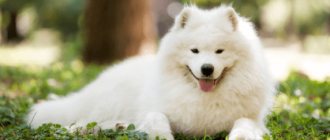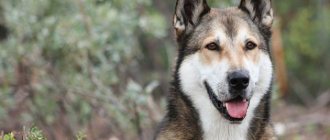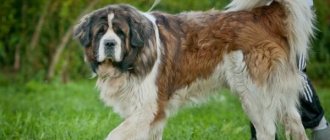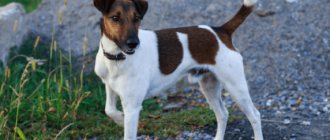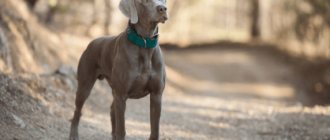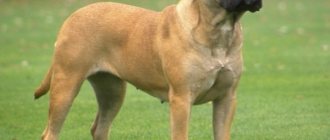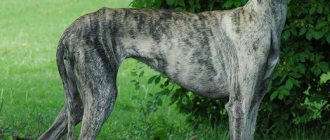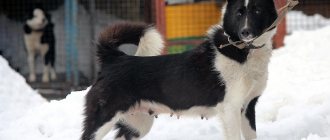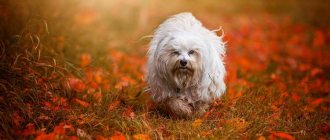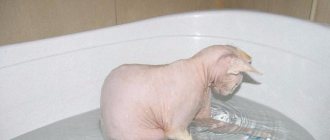Main characteristics
| Breed parameters | |
| Country of origin: | Russia |
| Weight of the breed: | males: 25-30 kg, females: 23-28 kg |
| Height at withers: | males: 53-57 cm, females: 52-55 cm |
| Temperament: | calm |
| Wool: | long |
| Role in human life: | companion, hunting |
In recent years, interest in aborigines has been growing and they are gradually gaining popularity. The Yakut Laika has a bright appearance, charisma, easy-going disposition and endurance. These dogs are truly magnificent and unique.
Choosing puppies
The Yakut Laika breed is characterized by intelligent and quick-witted individuals. Therefore, if you choose the right puppy, the process of training and obedience will go without problems.
It is best to choose such a dog in person from the kennel. The following recommendations should be followed:
- The most active and inquisitive baby deserves attention. He will be the first to run to food, will always be able to stand up for himself and will never look away.
- The bite should be scissor-shaped (the upper jaw covers the lower jaw).
- At the age of 1 month, the eyes of puppies are still dark.
- Large paws are a characteristic sign that the dog will grow up to be big.
- Pink skin, clean ears and eyes indicate a healthy dog.
- The coat color should be white. The coffee color indicates that there are impurities in the family.
- You should always focus on large puppies - they will grow into more resilient adult dogs.
Important! Dog puppies are blind and deaf at birth and at first they orient themselves in space only with the help of their sense of smell.
The price for a purebred Yakut Laika ranges from $350 to $550 and depends on a number of factors:
- the puppy's pedigree;
- fame and status of the breeder;
- availability of certificates from the nursery;
- participation of the puppy’s parents in exhibitions and their awards and prizes.
a brief description of
Among the huge variety of northern breeds, the Yakut Laika stands out for its unusual appearance and luxurious coat, which does not allow them to freeze in the cold season. A dog can sleep directly on the snow at sub-zero temperatures. Yakuts have an easy-going character and get along well with people.
In addition to their spectacular appearance, these animals are endowed with a number of working qualities, which are still actively used by the local population of Yakutia. Dogs are used for sledding, hunting and guarding livestock.
The main advantage of the breed is its excellent sense of smell, keen eyesight and good hearing, as well as perseverance and excessive hard work.
Origin story
For a long time, sled dogs of the peoples of the Far North were named after the place of residence of the indigenous people of the North. As a rule, human settlements in the northeastern part of Russia were concentrated along rivers. Each clan had a certain phenotype of dogs, unique only to that settlement.
Over the long period of study of the Far North, the aboriginal husky was called:
- Kolmyk;
- Verkhoyansk;
- Alazeevskaya;
- Okhotsk;
- Yakurskaya;
- polar;
- Evenskaya;
- Tunguska;
- Arctic;
- northeast riding.
It is not surprising, since for the first time dogs with a similar phenotype and similar characteristics were mentioned in chronicles since 1635.
Until the beginning of the 20th century, all the peoples of the North kept more than 30,000 dogs, but with the advent of a new era and technological progress, dog sleds were replaced by snowmobiles and other powerful equipment operating in the conditions of the Far North, and the population of the aboriginal breed decreased significantly.
Since then, the price of a Yakut Laika dog has increased many times over. There was a period in the history of the breed when finding a real northern Yakut dog was problematic. And only thanks to enthusiasts, whose names are literally written in golden letters in the history of the formation of the breed, the population of the Yakut Laika began to slowly resume. The breed is not yet recognized by the International Cynological Association FCI, but a place in the 5th group since 2004 has already been reserved for the Yakut Laika.
History of the breed
The Yakut Laika appeared and existed in difficult conditions in the north of the Yakut region. It is considered one of the oldest Aboriginal breeds and is an excellent hunter. The history of the Yakut Laika dates back more than 8 thousand years ago. This fact is confirmed by numerous finds of archaeologists in the form of remains, drawings and clay animals painted on the walls. Likes have served people faithfully since ancient times. They were able to survive and work productively in the north. Dogs have more than once rescued people from trouble and helped in finding the way home, and also protected human homes from attacks by wild forest inhabitants. Quite often the local population used them in sleds.
Excellent health and unpretentiousness, as well as the ability to live and work in sub-zero temperatures - these are the qualities that the breed acquired while living in the severe conditions of the cruel north.
Initially, the breed was called the Kolyma Laika. It was very popular until the invention of snowmobiles, however, when the modern miracle of technology appeared and the need for sled dogs disappeared, their population rapidly declined. There was a period when animals were on the verge of complete extinction.
The period of extinction was associated with experiments by Russian breeders who crossed purebred animals with completely different breeds. As a result, the real Yakuts almost completely disappeared. Only in the 90s did they get a second chance and were restored. Fifteen years later the first standard was adopted, and three years later the first exhibition was held.
Frequent illnesses and problems
Since the breed was bred almost naturally, the representatives are distinguished by good health. It is important to adhere to a diet and care regimen: a lack of microelements leads to bone deformation in childhood. Laikas are prone to the following diseases:
- eczema, dermatitis;
- oncology;
- gastrointestinal disorders;
- hip dysplasia;
- retinal atrophy;
- glaucoma;
- cataract;
- inflammation of the third eyelid.
If the pet is hot, skin problems appear; in old age, deformation of the joint pocket in the paws and the head of the bone is possible.
The Yakut Laika is distinguished by its calm and friendly disposition. It is easy to train; there is no need to use the whip method - the dog understands all commands, thanks to its developed intelligence. This is a loyal friend and an excellent hunter who loves long walks in the fresh air. Does not tolerate heat, it is difficult to take root in apartments. Space and cold are two of this breed’s favorite things.
Greyhounds - a twice famous breed
Greyhounds are not only known as the fastest dog breed, capable of reaching speeds of up to 72 km/h, but also as the only dog breed mentioned in the Bible (referring to Proverbs 30:31; King James Version).
Having a dog in the house can protect owners from asthma and colds
Research shows that children who lived in households with dogs had fewer allergies and were less likely to get sick than children who were raised in households without pets.
Collies were once considered a vicious breed
Collie was once considered a vicious breed of dog, mainly due to the fact that this breed is of Scottish origin, and the Scots were considered uneducated and poor people. Collies became a popular and prestigious breed in the 19th century when Queen Victoria became a fan.
Breed standard
The Yakut is a relatively small animal with well-developed muscles. Height is 56 cm, weight approximately 30 kg.
The neck is muscular, the head is in proportion to the body, high-set semi-erect or erect ears in the shape of a triangle. Almond-shaped eyes of a cool blue hue. Various eyes, black and brown colors are allowed. The surface of the nose is convex and moist. Lips without dewlap, dry, teeth large, even, white, bite is normal.
The body is strong, the chest is wide. The limbs are muscular and well developed. The tail is set high on the tailbone, well feathered, and curled into a curl typical of all huskies.
The coat is long, hard, with a well-developed undercoat. There is a thick collar on the neck and feathering on the legs. A disadvantage is considered to be too soft, wavy coat.
Acceptable colors: black and white, white with gray and red spots, red and white and white and red, black with red spots. White is sometimes found. Any other solid color is considered disqualifying.
Description of the standard
The Yakut Laika breed standard was approved in 2005. Before this, the breed was called the Kolyma Laika. The standard is registered in the RKF, but the Yakut Laika breed is not recognized by the FCI. According to the standard, YaL belongs to the group of sled and draft dogs. And today it is actively used in competitions. The breed is actively gaining popularity, since the Yakut has all the qualities for sledding.
The Yakut Laika is powerful, strong, hardy, unpretentious, and capable of working for a long time. Its thick coat allows it to survive in the harshest conditions of the north and withstand any frost.
Below is the standard of the Yakut Laika:
- The head is proportional to the size of the body. The shape resembles a pointed wedge. The forehead is high, the stop is well defined.
- The nose is black or brown. The breed standard excludes the absence of pigment on the nose and lips.
- The eyes are almond-shaped and not deep set. The color can be brown, blue or multi-colored (one brown, the other blue).
- The ears are triangle-shaped, thick and erect.
- The body is strong and muscular.
- Tail - forms a ring, thrown over the back.
- Limbs – both forelimbs and hind limbs are parallel and straight. Elbows point back and fit tightly to the body. The paws are well furred and large.
- The coat is thick with dense undercoat. Rough to the touch. There is a thick mane on the neck, especially in males, and feathering on the hind legs.
- Color – white with various variations: white-black, white-brown, white-gray. Another solid color is a sign of disqualification.
Characteristics of the breed exclude: short legs, barrel-shaped chest, sluggish movements, wavy, soft coat.
Character and temperament
The main feature of the Yakut Laika is its immense devotion to its owner, friendliness and excessive efficiency. These animals love all members of their family very much, however, for them there is always the most important one - the “leader”. As a rule, this is the head of the family. It is his commands that are carried out unconditionally; the pet may sometimes not hear or ignore others.
Yakut will never become a good guard, since his attention is very easy to redirect in another direction. And this is not surprising, because huskies have never been watchdogs; they are ideal hunters and sled dogs.
They behave well with children, they enjoy playing outdoor games with them, take part in pranks and never offend them, even if the child inadvertently causes pain. The Yakuts patiently and steadfastly endure all the hardships and periods of growing up of children.
Aggression is extremely low and can only appear during the hunt or when someone close to you is in real danger. They treat strangers with suspicion, but without excessive anger or signs of aggression.
It is important to note that Yakuts are dominant, so you need to immediately identify yourself and let your pet know who is boss in the house.
Character
The main character traits of the Yakut Laika are devotion, love of freedom, friendliness, determination, and passion.
The Yakut woman in her family treats all adults equally, but among them, in her eyes, one person stands out as the leader. It is his commands that he carries out unquestioningly; the Laika may simply “not hear” the demand from other members of the family.
A Yakut woman will not make an ideal security guard. It is very easy to redirect her attention and distract her from the protected object. This is understandable, because the husky is not a watchdog, it is an ideal hunter, and also a sled dog.
With children, the dog behaves like a caring nanny and a tireless playmate. A Yakut woman will never hurt a child. She steadfastly endures all the pranks of the kids.
Aggression is not inherent in likes. It manifests itself when necessary during a hunt or in situations where family members are in danger. The Yakut woman treats strangers with distrust, wariness, but without malice. As the dog gets to know each other, it accepts the stranger into its circle of friends.
It is worth noting that the Yakuts are prone to dominance. If you keep several dogs, a male husky will definitely defend his rights as a leader. You can combat this with proper education. Regarding gender, females are smaller than males, but in terms of character, a female in a dangerous situation is capable of fighting with any opponent. It is no secret that in many cases the female is the leading dog in sledding.
Care and maintenance
By nature, these dogs are Siberian, therefore, they prefer the harsh winters of the north to the southern climate. For this reason, keeping them in a cramped apartment is not recommended. In a confined space they feel very stuffy and uncomfortable.
An acceptable option for a Yakut is a private house with the possibility of permanent access to the yard or a spacious enclosure with its own house. These dogs do not need a warm bed, a fireplace or human presence 24 hours a day. At the same time, she needs the opportunity to throw out all her energy.
If you keep a husky in the city, the pet can quickly lose interest in life and feel unwell. If you really want such a pet, but living is only possible in an apartment, then you should take care of frequent and long walks, at least 60 minutes. You will also have to go out into nature often so that the animal can run around as much as possible.
When living in a house or apartment, the dog should have its own place with bedding (a regular rug will be enough), a bowl of water and food, and several useful toys to fill its leisure time.
To maintain the beauty and health of your pet, you must do the following:
- Long and thick wool without proper care will quickly turn into “felt boots” and nothing but tangles. To avoid this, you need to comb your pet at least twice a week with a special brush, thus removing frozen hairs and unraveling tangles. During the molting period, the procedure should be carried out daily.
- You should bathe several times a year, the rest of the time it is enough to wipe the coat with a damp cloth and wash the paws. You should not frequently bathe your dog using special cosmetics, as this can upset the natural balance and harm the skin.
- The ears are cleaned three times a week using a special lotion or a wet wipe. Under no circumstances should you use human ear sticks, as improper handling can damage the ear canal or eardrum.
- Natural discharge from the eyes is removed with a moistened cotton pad.
- Teeth should be brushed several times a week. You need to accustom your four-legged friend to this procedure from puppyhood.
To raise a strong and healthy pet, you need to properly feed and care for it, and also undergo regular veterinary examinations.
Characteristic
The character of the Yakut Laika is proud and independent, but endowed with the ability to become extremely attached to its owner. Dogs of this breed are accustomed to making their own decisions based on the situation, and blindly trust only a person who enjoys unconditional authority with them. Laikas are very devoted and faithful; they cannot do without human attention, having a hard time experiencing loneliness. They cannot be left without communication for a long time. These dogs are very sensitive and touchy. They must be handled with extreme caution, without using excessive pressure or physical force.
When hunting, Yakut huskies reveal their full potential of physical qualities and intelligence. They are used for bear and elk hunting, training pets for this purpose from puppyhood. They are inquisitive and curious, they can explore new territories with joy and enthusiasm, and have proven themselves excellent in searching. But in the excitement of the hunt, huskies always act to please the owner, without putting their own interests above the owner’s desires. These dogs are excellent guards, but due to their natural curiosity they can let their owner down if something distracts them.
These four-legged creatures are created for families with children. They perceive babies as objects of play and protection. They treat strangers neutrally, without aggression. The Yakut Laika breed is considered “talkative” and noisy. These are unsurpassed leaders who will easily give up their place as leader to anyone who truly proves their superiority to them. It is for this reason that, in order not to provoke fights, dog sled drivers appoint two leaders in the pack. With all this, huskies get along well with other pets - both dogs and cats, building trusting, friendly relationships with them.
Nutrition
In their natural environment, these animals eat quite fatty foods. The local population feeds their dogs porridge with meat, cooked in broth, sometimes adding extra fat. If the dog lives in warmer latitudes, the diet must be reconsidered, since such fatty foods can harm health and cause obesity.
Taking into account the fact that in urban conditions a pet receives much less stress than in a free-range environment, food should be more easily digestible and balanced. The basis of the diet should be lean meat; it can be given both raw and cooked. And also sea fish must be present in the weekly menu. As a supplement, you can add cottage cheese, vegetables and safe fruits. Sugar bones can be a treat.
It is not recommended to give industrial feed to the Yakuts, however, if it is not possible to feed only natural products, then the feed can be introduced as a supplement, but in no case as the main diet.
What kind of husky does a Yakut hunter need?
Tuvan Laika
Since the early 1970s, native huskies have begun to deteriorate everywhere, mixing with all sorts of imported breeds and crossbreeds. The reason, as elsewhere in Siberia, is free content. The huskies exported from Yakutia to create the factory type of East Siberian huskies have proven themselves well. From Pirate (owner Filippov N.E.), taken to St. Petersburg, Buran (owner Ryasny N.L.) was received, having diplomas of the 1st class. by bear and wild boar.
According to Geitz’s description, in the 1960s, Yakut huskies were distinguished by their large stature and were widely used in hunting ungulates. In the book by L.P. Sabaneev’s “Greyhounds and Hounds,” written at the end of the 19th century, says that in the village of Sogostyr, at the mouth of the Lena, there were very large greyhound-type huskies, which were used to hunt arctic foxes and wild deer. Since the beginning of the 1980s, pedigree huskies, especially West Siberian ones, began to be intensively imported into the republic. From the Novosibirsk nursery alone, 300 puppies were brought in in a short time; the Republican Society of Hunters took the most active part in this. Puppies were bred among amateur hunters and fishermen.
At this time, there is little left of the breed huskies; In addition, rural commercial hunters have a negative opinion about the husky breed. The alien huskies were kept as their local huskies and compared. No special food was prepared for the native huskies; they ate what was left from the table, pieces of skins, carrion, carcasses and entrails of animals; in the summer they moused and hunted hares. They didn’t make warm kennels in winter; from childhood I remember dogs lying calmly in the snow in fifty-degree frost.
| Photo from the 50s taken in Evenkia. (photo by S.N. Rozov, anthropology room at TSU) |
Hunting for ungulates begins in mid-September. Moose hunting is especially developed, which is why moose are frightened and constantly chased by wolves and dogs. When lying down, it is better to stop dogs of a calm disposition, approaching the animal at a light gallop or trot, barking from a distance, carefully. If the animal still leaves, then viscosity and fast legs are needed. The dog should chase the animal from the side and bark aggressively from the front. Usually the elk does not leave good dogs for longer than 1.5-2 hours and begins to give up.
Viscous dogs chase for days, so in addition to endurance, dogs are required to have good orientation. Local hunters require their hunting dogs to cast their voice only on large animals; dogs that constantly bark to no avail at chipmunks and squirrels are harshly rejected. It is considered shameful for the owner of a famous beast dog to chase after small change.
Aboriginal huskies, having strong genes of healthy blood, worked without strong training in the first season and quickly understood the requirements of the owner.
In October, the fishing season begins - sable hunting. Tall, strongly built, well-dressed dogs with strong, non-tearing paws are best suited for such a hunt. In November we experience temperatures of forty degrees below zero, and the snow from severe frost hardens like grains of glass. The paws of imported huskies are torn off amazingly quickly, the interdigital membrane cracks, and the dogs fail.
Aboriginal dogs had strong paws, like sled dogs, almost like a wolf. To hunt for sables, my partner and I traveled 250 km on horseback. This distance with loaded horses was covered in a week, and back in five days. Some dogs, even before reaching the grounds, clung to the horse's tail. We hunted without rest every day for a little over a month.
Until the end of the season, out of 4-5 dogs, one male, Tommot, originally from Olekma, stood up with dignity. When other dogs were only following a fresh scent, he himself searched for sables with a wide search, sometimes barking at a sable ten miles away from me, which his partner used to hunt for me. Impulsive, reactive dogs burn out faster during such a hunt. Dogs with a strong constitution, with a wider loin and belly, withstand it better than lean dogs; Strong, durable paws also have a very important advantage for all winter hunting.
After the sable hunting season, muskrat hunting begins until mid-April. This is a very annoying activity for dogs; the dog cannot see the animal, and low temperatures interfere. Most dogs get tired of searching for huts after a couple of weeks. Obedient dogs that do not pay attention to squirrels and horses work better, since in winter Yakut horses hoof around the lakes, and in winter squirrels can be heard half a mile away.
| Hunter I.N. Kaplin (Katangsky region) after a successful moose hunt. Photo from the book by A.V. Geits "East Siberian Laika" (1968) |
Aboriginal huskies, exported from the nearby regions of Evenkia and Nizhnyaya Tunguska, Irkutsk region, are better suited for such hunting. Fortunately, there are still some native dogs there, although not in the best condition due to close inbreeding in small villages. Factory-bred orientals improved by these natives also work well.
I do not intend to cover other breeds of huskies with this, it’s just that what Mother Nature has done for thousands of years in the most extreme climates cannot be replaced by breeds that are sometimes even wonderful in all respects, but came from milder climatic geographical latitudes, with the specificity of use inherent in these conditions. hunting.
Yes, urban hunters who hunt in the warm season have a short time, and here they can hunt with Westerners. I know two such hunters who have the best dogs of Moscow animal blood, with whom they are satisfied.
At this time in the Republic of Sakha (Yakutia) they do not pay any attention to the development of hunting dog breeding. In 1992, due to the crisis, the nursery of East Siberian huskies was liquidated under the State Agricultural Industry of the YASSR; four dogs from this nursery in 1989 in the Irkutsk squirrel, bear and wild boar competitions, having won 9 diplomas, took first place (“Hunting and Game Management” , 1990, N№ 6). Since 1992, I have been keeping dozens of Orientals originally from this nursery, during this time I went to different offices dealing with hunting and breeding, but everywhere I received a refusal as soon as it came to supporting my business.
One can only be surprised that officials living in a republic that occupies one-fifth of the Russian Federation, where hunting with dogs is a national tradition inherited from their ancestors, do not understand the need for hunting dog breeding. Moreover, local newspapers are full of reports about the success of fur auctions and the number of furs sold and fur coats made, coats, etc., obtained by hunters with the help of huskies.
Based on all of the above, it should be considered that the most suitable for our extreme climate are the East Siberian huskies of aboriginal blood, which are still somewhat preserved in Evenkia and Lower Tunguska, in the north of the Irkutsk region. If urgent measures are not taken to preserve the remaining local huskies, in 10-15 years they will disappear irrevocably. Only the preservation of local huskies in their habitats will revive the prosperity of the breed as a whole and provide the hunters of Eastern Siberia with the most adapted huskies.
Preserving native huskies in their habitats will provide fresh blood to factory-run easterners, whose gene pool is not so rich. Even among modern factory easterners, apparently, the blood of the Baikal huskies predominates, a less hardy type than the huskies of the above-mentioned regions, where in winter the temperature is almost like ours, often minus 55 degrees. Dogs adapted to cold weather are better able to withstand hunger, their food digestibility is higher, and they are very hardy.
| The Magi are not afraid of mighty rulers, And they do not need a princely gift, Their prophetic language is truthful and free And friendly with the will of heaven... A.S. Pushkin |
In the end, Russians are indebted to the Easterners: it is from the area of the Easterners that at all times the most “soft gold” of the best quality, of which Russia is proud, has been and is being mined. It would be a shame if the remaining aboriginal huskies, bred over thousands of years by the small peoples of the North, disappeared due to the inattention of the larger nations for decades.
Ayal Danilov November 8, 2013 at 00:00
Health
Like all people from the northern regions, the Yakuts are distinguished by excellent health. With proper care and proper nutrition, animals live long enough and do not cause any problems to their owner.
In order for your dog to be in good shape and feel good, it is necessary to undergo regular examinations by a veterinarian, be vaccinated and treated against ectoparasites and helminths.
Like all animals, huskies are susceptible to certain diseases:
- dysplasia;
- renal failure;
- diabetes;
- diseases of the gastrointestinal tract;
- eye diseases.
Conditions of detention
Yakut Laikas originated from the northern regions, so the most favorable region for them are places with a cold climate.
The Yakut Laika will not feel comfortable in an apartment, since its huge reserve of energy will not be fully compensated. Dogs of this breed need free space, movement, long walks and games.
Otherwise, the dog’s character and mood may become unbearable: signs of aggression and a desire to spoil things may be observed.
The Yakut Laika is a versatile dog that can become an excellent watchdog, hunting companion, sled dog and loyal friend, but it is worth remembering that by their nature they are working dogs, and regular exercise is essential for them, so it is not recommended to own this breed of dog to the apartment. The ideal place to keep them would be a country house.
How to choose a puppy?
The four-legged aborigines of the northern lands are not as simple as they might seem at first glance. They have features that it is advisable to get to know before bringing a puppy into the house. In addition, it is necessary to enlist the support and approval of all family members.
It is advisable to buy a puppy from a specialized nursery, and not from a photo on the Internet or at a bird market. Naturally, puppies from professional breeders will cost slightly more than those from breeders. However, if you buy it in the right place, you will get a truly purebred animal, and not a parody of it.
A responsible breeder will never give away a puppy under three months of age. It is at this time that the baby can leave the nursery and leave the mother without psychological trauma. Before purchasing, it is important to read all the documents of the parents and inquire about the documentation for the baby. Upon delivery, the puppy must have a veterinary passport with vaccination records and a pedigree or birth certificate.
When examining your future pet, you need to pay attention to the following:
- general condition;
- fatness;
- cleanliness of mucous membranes;
- activity;
- reaction to a stranger;
- wool.
When purchasing a Yakut Laika puppy, it is important to remember that this is not a toy, but a responsibility for many years. You need to take care of your pet, devote a lot of time to it, go for walks, monitor its nutrition, appearance and health.
Content Features
Tempered by harsh living conditions, these huskies almost never complain about their health. They are unpretentious in food and do not require special care. It is best to keep such dogs in enclosures; they may feel cramped and uncomfortable in an apartment.
Important! Cold is the element in which the Yakut Laika feels best. In the heat and summer heat, these four-legged animals may feel unwell. During warm periods, the owner must ensure that the dog has access to a cool place in the apartment or basement in the house.
Manipulations that are carried out for hygienic purposes (cleaning ears, teeth) are carried out once every 3-4 days. Yakut dykes need to comb their fur only during periods of intense shedding.
In order for the dog to remain healthy and cheerful for as long as possible, it needs to take part in the hunt at least sometimes. If the owner does not do this professionally, especially for the pet, you can organize a comic hunt with a toy instead of a victim.
You can find a Yakut Laika puppy either in a specialized nursery or in a monokennel of the breed. It’s interesting that you can take either a two-month-old puppy or an already grown animal into your home. Representatives of this breed get used to a new home and environment very quickly.
Similar articles
